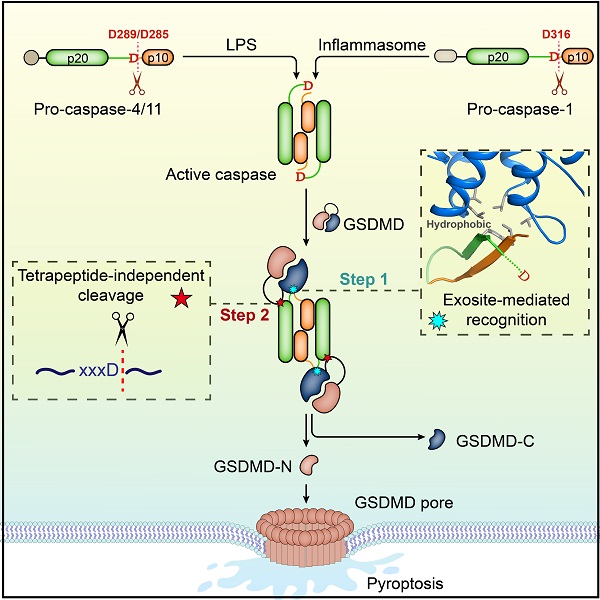
Pyroptosis is one of the most important innate defenses against infections and endogenous dangers. Excessive pyroptosis causes inflammatory diseases such as sepsis. Over the past years, progress has been made in pyroptosis studies.
A study published in Cell deciphered the precise molecular mechanism of pyroptosis executioner GSDMD recognition by activated caspases in innate immunity. It was conducted by WANG Dacheng and DING Jingjin’s group from the Institute of Biophysics of the Chinese Academy of Sciences, and SHAO Feng’s group from National Institute of Biological Sciences.
Both caspase-1 and caspase-4/11 belong to a large conserved family of cysteine proteases, named caspase. All caspases are synthesized as inactive zymogens containing a conserved protease domain divided into a large p20 and a small p10 subunit. Their activation requires cleavage between the p20 and the p10 which generate a p20/p10 heterodimer.
In this study, the researchers discovered that LPS-stimulated caspase-4 undergoes autoprocessing in vitro and in treated cells. Unlike caspase-11 which autoprocesses after Asp285 at the N-terminus of p10, caspase-4 autocleaves at two sites, Asp270 at the C-terminus of p20 and Asp289 at the N-terminus of p10. Mutagenesis analyses further confirmed that Asp289/285 in caspase-4/11 is the only autoprocessing site critical for their activation by cytosolic lipopolysaccharide (LPS) for cleaving GSDMD and inducing pyroptosis.
The dogma in caspase biochemistry is that all caspases recognize a tetrapeptide motif within a substrate and cleave after the aspartate. Caspases in apoptosis often cleave a dozen of substrates. However, caspase-4/11 only have one known physiological substrate GSDMD, and caspase-1 cleave two more cytokines IL-1β/18 besides GSDMD. The caspase dogma cannot explain why caspases in innate immunity bear such a narrow substrate spectrum.
Surprisingly, the researchers found that the GSDMD-C domain, but not the cleavage-site tetrapeptide, mediates the recognition of GSDMD by activated caspase-4/11. They determined the crystal structures of the complexes between autoprocessed caspase-4/11 and GSDMD-C domain.
The complex structures showed that autoprocessed caspase-4/11 p20/p10 further dimerize to form a heterotetramer. The caspase-4/11-GSDMD complex structures also demonstrated that N-terminal extension of p10 would introduce inappropriate structural clashes to GSDMD-C domain, explaining why caspase-4/11 need to be precisely processed at Asp289/285. Mutagenesis analyses confirmed the hydrophobic interface is the structural basis for caspase-GSDMD recognition and GSDMD-cleavage-mediated pyroptosis.
The researchers further investigated the caspase-1 recognition of GSDMD. Crystal structure of caspase-1-GSDMD-C complex shows a similar GSDMD-recognition mode as the case of caspase-4/11.
This study provides complete understanding of caspase-1/4/11 autoprocessing and recognition of pyroptosis executioner GSDMD in innate immunity. The reported caspase-GSDMD complex structures are the first structures of enzyme-substrate complex in caspase studies.
Besides, the findings provide in-depth insights into substrate recognition and enzymatic mechanism of caspase family. Caspases have important functions in cancer and immunity and are potential drug targets. However, it has been challenging to obtain compounds that are sufficiently selective for a particular caspase given structural conservation in the catalytic pocket among all caspases. Thus, the GSDMD-binding hydrophobic pocket in caspase-1/4/11, which is outside of the catalytic site, suggests a new space for developing caspase drugs to treat pyroptosis-caused inflammatory diseases.

Schematic diagram of the molecular mechanism for GSDMD targeting by autoprocessed caspases in pyroptosis. (Image by Dr. DING Jingjin’s lab)

86-10-68597521 (day)
86-10-68597289 (night)

86-10-68511095 (day)
86-10-68512458 (night)

cas_en@cas.cn

52 Sanlihe Rd., Xicheng District,
Beijing, China (100864)

